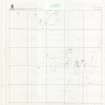Pricing Change
New pricing for orders of material from this site will come into place shortly. Charges for supply of digital images, digitisation on demand, prints and licensing will be altered.
Doon Hill
Fort (Prehistoric)
Site Name Doon Hill
Classification Fort (Prehistoric)
Canmore ID 69056
Site Number NX65NE 26.01
NGR NX 6875 5660
Datum OSGB36 - NGR
Permalink http://canmore.org.uk/site/69056
- Council Dumfries And Galloway
- Parish Twynholm
- Former Region Dumfries And Galloway
- Former District Stewartry
- Former County Kirkcudbrightshire
Field Visit (18 May 1990)
NX65NE 26.1 6875 5660.
This fort is situated on a spur, defined by steep slopes to the E and W, the E side being marked by rocky outcrops. On the N side of the fort the ground slopes away less steeply, as it does to the S where the spur tapers. The area around the fort and its interior have been heavily improved and there are a number of plough scars along breaks of slope, which have accentuated a series of natural mounds and ridges in the interior. The lines of ramparts are visible on the W and N from the SW to the NE sides of the spur. The lines of the defences vary from a marked break in slope to a bank up to 3.6m thick and 0.2m high. On the W side the defences appear to have been created by scarping and dumpting in order to produce a bank and to accentuate the steepness of the slope, thus creating a stepped profile. No entrances can be identified with certainty, although in the S and NNE two small gullies run up into the interior of the fort and both of these might have been suitable locations.
Visited by RCAHMS (DCC) 18 May 1990.
Note (20 December 2013 - 23 May 2016)
This fort is situated on the broad crest of a steep-sided spur, which forms part of the high ground on the E side of the Tarff Water S of Ringford. Roughly kite-shaped on plan, the fort is tailored to the topography and tapers towards the SW, measuring about 250m from NE to SW by a maximum of 140m transversely (2.2ha) within its defences. The interior and the surrounding area have been heavily improved, with the result that plough scars have accentuated a series of natural mounds, ridges and terraces on the hill. Nevertheless, the lines of at least two ramparts can be distinguished on the W and N flanks of the hill, extending from the SW round to the NE; their line is lost in the outcrops that form the SE flank of the hill, which is also overgrown with gorse. Heavily reduced, they range from scarps forming three stepped terraces in places on the W flank of the hill, to a bank up to 3.6m thick and 0.2m high on the N. No entrances can be identified with certainty, although small gullies on the NNE and S respectively run up into the interior and mark likely points of access. The remains of a rectangular building are situated within the S end of the interior.
Information from An Atlas of Hillforts of Great Britain and Ireland – 23 May 2016. Atlas of Hillforts SC0249








